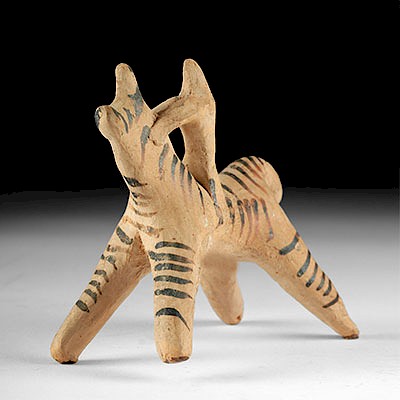Sumerian Stone Cow - Ninsun or Geme Sin
Lot 108
About Seller
Artemis Fine Arts
686 S Taylor Ave, Ste 106
Louisville, CO 80027
United States
Selling antiquities, ancient and ethnographic art online since 1993, Artemis Gallery specializes in Classical Antiquities (Egyptian, Greek, Roman, Near Eastern), Asian, Pre-Columbian, African / Tribal / Oceanographic art. Our extensive inventory includes pottery, stone, metal, wood, glass and textil...Read more
Estimate:
$2,400 - $3,600
Absentee vs Live bid
Two ways to bid:
- Leave a max absentee bid and the platform will bid on your behalf up to your maximum bid during the live auction.
- Bid live during the auction and your bids will be submitted real-time to the auctioneer.
Bid Increments
| Price | Bid Increment |
|---|---|
| $0 | $25 |
| $300 | $50 |
| $1,000 | $100 |
| $2,000 | $250 |
| $5,000 | $500 |
| $10,000 | $1,000 |
| $20,000 | $2,500 |
| $50,000 | $5,000 |
| $100,000 | $10,000 |
| $200,000 | $20,000 |
About Auction
By Artemis Fine Arts
Oct 25, 2018
Set Reminder
2018-10-25 11:00:00
2018-10-25 11:00:00
America/New_York
Bidsquare
Bidsquare : Antiquities from Egypt, Greece, Italy, Asia
https://www.bidsquare.com/auctions/artemis-gallery/antiquities-from-egypt-greece-italy-asia-3538
Featuring Egyptian, Greek, Roman, Etruscan, Near Eastern, plus Asian art from Central and Far East. If you love the classics, this is the sale for you. Artemis Fine Arts info@artemisfinearts.com
Featuring Egyptian, Greek, Roman, Etruscan, Near Eastern, plus Asian art from Central and Far East. If you love the classics, this is the sale for you. Artemis Fine Arts info@artemisfinearts.com
- Lot Description
Mesopotamia, Nippur, Sumerian, ca. 2700 to 2600 BCE. Finely carved from a mottled stone of beige hues with integral black markings and white deposits, a cow lying in a prone position, perhaps symbolizing Ninsumun or Ninsun - whose name means "lady of the wild cows" - and according to Sumerian mythology is a goddess beloved for being the mother of the celebrated hero Gilgamesh, as well as the tutelary goddess of Gudea of Lagash. It is also possible that this sculpture represents the pregnant cow known as Geme-Sin belonging to Nanna/Suen/Sin - the Mesopotamian moon god. The ancient text entitled "A Cow of Sin" tells of how Sin eased Geme-Sin's birthing pains, and the incantation ends this way, "may this woman give birth as easily as Geme-Sin". Furthermore, the moon god, whose primary symbol was actually a bull, was also associated with fertility, since the timing of its transformations was related to menstrual cycles, and by extension the cow. Size: 4.5" L x 2.625" H (11.4 cm x 6.7 cm)
Other forms of Sumerian visual culture representing a cow serve to demonstrate how this ancient culture honored this animal and/or deities associated with it. For example, see this Sumerian stone cow amulet at the Metropolitan Museum of Art (62.70.65) - https://www.metmuseum.org/art/collection/search/325470.
Provenance: private East Coast, USA collection
All items legal to buy/sell under U.S. Statute covering cultural patrimony Code 2600, CHAPTER 14, and are guaranteed to be as described or your money back.
A Certificate of Authenticity will accompany all winning bids.
We ship worldwide and handle all shipping in-house for your convenience.
#137154Small old chips to right flank - possibly inherent to the stone's surface. Nice deposits and smooth, lustrous patina.Condition
- Shipping Info
-
All shipping is handled in-house for your convenience. Your invoice from Artemis Gallery will include shipping calculation instructions. If in doubt, please inquire BEFORE bidding for estimated shipping costs for individual items.
-
- Buyer's Premium



 EUR
EUR CAD
CAD AUD
AUD GBP
GBP MXN
MXN HKD
HKD CNY
CNY MYR
MYR SEK
SEK SGD
SGD CHF
CHF THB
THB
















